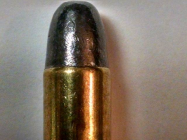Loading 38s and 357s with cast bullets.
Actually I have been loading off and on for several years.
Never thought much about it before but I'm loading for 38-44 now
How do you determine the proper crimp.
These are all cast bullets. I can't push the bullets any further into the case by hand.
Thanks,johnny
Actually I have been loading off and on for several years.
Never thought much about it before but I'm loading for 38-44 now
How do you determine the proper crimp.
These are all cast bullets. I can't push the bullets any further into the case by hand.
Thanks,johnny












